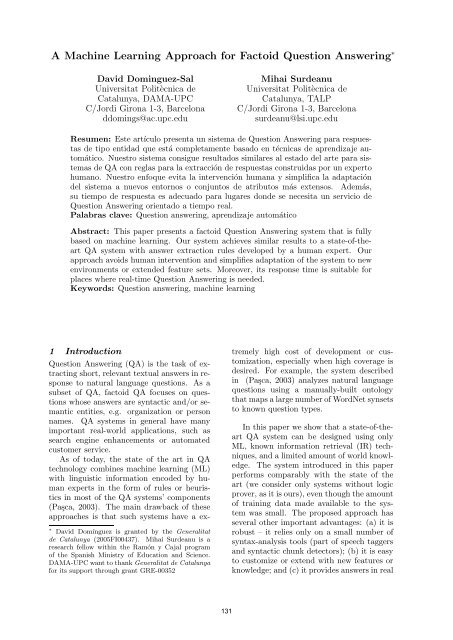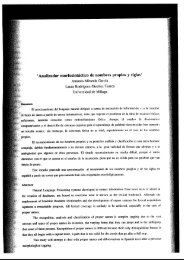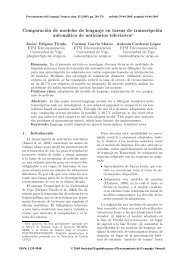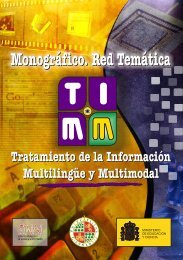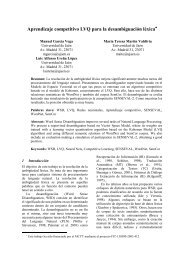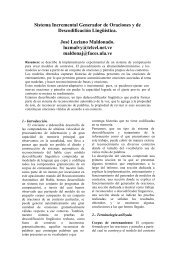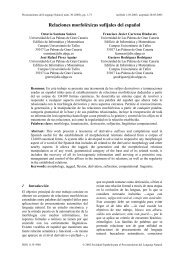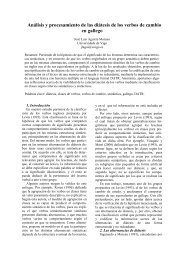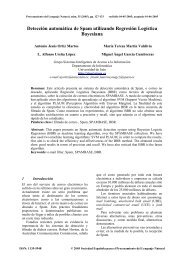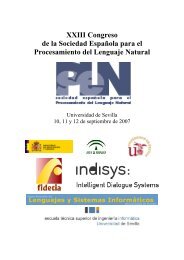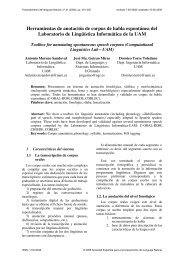A Machine Learning Approach for Factoid Question Answering - sepln
A Machine Learning Approach for Factoid Question Answering - sepln
A Machine Learning Approach for Factoid Question Answering - sepln
Create successful ePaper yourself
Turn your PDF publications into a flip-book with our unique Google optimized e-Paper software.
A <strong>Machine</strong> <strong>Learning</strong> <strong>Approach</strong> <strong>for</strong> <strong>Factoid</strong> <strong>Question</strong> <strong>Answering</strong> ∗<br />
David Dominguez-Sal<br />
Universitat Politècnica de<br />
Catalunya, DAMA-UPC<br />
C/Jordi Girona 1-3, Barcelona<br />
ddomings@ac.upc.edu<br />
Mihai Surdeanu<br />
Universitat Politècnica de<br />
Catalunya, TALP<br />
C/Jordi Girona 1-3, Barcelona<br />
surdeanu@lsi.upc.edu<br />
Resumen: Este artículo presenta un sistema de <strong>Question</strong> <strong>Answering</strong> para respuestas<br />
de tipo entidad que está completamente basado en técnicas de aprendizaje automático.<br />
Nuestro sistema consigue resultados similares al estado del arte para sistemas<br />
de QA con reglas para la extracción de respuestas construidas por un experto<br />
humano. Nuestro enfoque evita la intervención humana y simplifica la adaptación<br />
del sistema a nuevos entornos o conjuntos de atributos más extensos. Además,<br />
su tiempo de respuesta es adecuado para lugares donde se necesita un servicio de<br />
<strong>Question</strong> <strong>Answering</strong> orientado a tiempo real.<br />
Palabras clave: <strong>Question</strong> answering, aprendizaje automático<br />
Abstract: This paper presents a factoid <strong>Question</strong> <strong>Answering</strong> system that is fully<br />
based on machine learning. Our system achieves similar results to a state-of-theart<br />
QA system with answer extraction rules developed by a human expert. Our<br />
approach avoids human intervention and simplifies adaptation of the system to new<br />
environments or extended feature sets. Moreover, its response time is suitable <strong>for</strong><br />
places where real-time <strong>Question</strong> <strong>Answering</strong> is needed.<br />
Keywords: <strong>Question</strong> answering, machine learning<br />
1 Introduction<br />
<strong>Question</strong> <strong>Answering</strong> (QA) is the task of extracting<br />
short, relevant textual answers in response<br />
to natural language questions. As a<br />
subset of QA, factoid QA focuses on questions<br />
whose answers are syntactic and/or semantic<br />
entities, e.g. organization or person<br />
names. QA systems in general have many<br />
important real-world applications, such as<br />
search engine enhancements or automated<br />
customer service.<br />
As of today, the state of the art in QA<br />
technology combines machine learning (ML)<br />
with linguistic in<strong>for</strong>mation encoded by human<br />
experts in the <strong>for</strong>m of rules or heuristics<br />
in most of the QA systems’ components<br />
(Pa¸sca, 2003). The main drawback of these<br />
approaches is that such systems have a ex-<br />
∗ David Domínguez is granted by the Generalitat<br />
de Catalunya (2005FI00437). Mihai Surdeanu is a<br />
research fellow within the Ramón y Cajal program<br />
of the Spanish Ministry of Education and Science.<br />
DAMA-UPC want to thank Generalitat de Catalunya<br />
<strong>for</strong> its support through grant GRE-00352<br />
131<br />
tremely high cost of development or customization,<br />
especially when high coverage is<br />
desired. For example, the system described<br />
in (Pa¸sca, 2003) analyzes natural language<br />
questions using a manually-built ontology<br />
that maps a large number of WordNet synsets<br />
toknownquestiontypes.<br />
In this paper we show that a state-of-theart<br />
QA system can be designed using only<br />
ML, known in<strong>for</strong>mation retrieval (IR) techniques,<br />
and a limited amount of world knowledge.<br />
The system introduced in this paper<br />
per<strong>for</strong>ms comparably with the state of the<br />
art (we consider only systems without logic<br />
prover, as it is ours), even though the amount<br />
of training data made available to the system<br />
was small. The proposed approach has<br />
several other important advantages: (a) it is<br />
robust – it relies only on a small number of<br />
syntax-analysis tools (part of speech taggers<br />
and syntactic chunk detectors); (b) it is easy<br />
to customize or extend with new features or<br />
knowledge; and (c) it provides answers in real
time due to its simple architecture based on<br />
a small number of multi-class classifiers.<br />
This paper is organized as follows. In Section<br />
2 we describe the <strong>Question</strong> <strong>Answering</strong><br />
system. Section 3 describes the empirical<br />
evaluation. We conclude with a discussion<br />
comparing our ML approach with a state-ofthe-art<br />
Answer Extraction system based on<br />
human developed extraction rules.<br />
2 Architecture<br />
The QA system introduced in this paper uses<br />
a typical architecture consisting of three components<br />
linked sequentially: <strong>Question</strong> Processing<br />
(QP), which identifies the type of the<br />
put question, followed by Passage Retrieval<br />
(PR), which extracts a small number of relevant<br />
passages from the underlying speech<br />
transcriptions, and finally Answer Extraction<br />
(AE), which extracts and ranks exact answers<br />
from the previously retrieved passages.<br />
This section describes all these components.<br />
2.1 <strong>Question</strong> Processing<br />
The QP component detects the type of the<br />
input questions by mapping them into a twolevel<br />
taxonomy consisting of 6 question types<br />
and 53 subtypes:<br />
type subtype<br />
ABBREVIATION abbreviation, expression abbreviated<br />
ENTITY animal, body organ, color, creative<br />
work, currency, disease, event, food,<br />
instrument, language, letter, other,<br />
plant, product, project, religion,<br />
sport, symbol, system, technique,<br />
equivalent term, vehicle, special word<br />
DESCRIPTION definition, description, manner,<br />
reason<br />
HUMAN group, individual, title, description<br />
LOCATION city, country, mountain, other, state<br />
NUMERIC angle, code, count, date, distance,<br />
money, order, other, period, percent,<br />
speed, temperature, size, weight<br />
In our system there is a one-to-one mapping<br />
from question type to the category of<br />
the expected answer. For example, the tuple<br />
LOCATION:country entails that the answer is<br />
a named entity of type LOCATION.<br />
Because the NERC used in the experiments<br />
reported in this paper extracts<br />
only 3 types of entities (Person, Location<br />
and Organization), we selected questions<br />
whose answers correspond to those<br />
types. We map question types to answer<br />
types using the following mapping:<br />
Answer Type type:subtype<br />
PERSON HUMAN:individual<br />
LOCATION LOCATION:{city, country,<br />
mountain, other,stated}<br />
ORGANIZATION HUMAN:group<br />
David Dominguez-Sal and Mihai Surdeanu<br />
132<br />
Note that the three selected types make<br />
Answer Extraction more difficult. There are<br />
two main reasons: (a) our answer types are<br />
difficult to be identified. For example, (Surdeanu,<br />
Turmo, and Comelles, 2005) report<br />
F-measure differences of more than 16 points<br />
higher <strong>for</strong> Money entities than Organization<br />
ones. Moreover, (Surdeanu, Turmo, and<br />
Comelles, 2005) show that Person and Organization<br />
types figure among hardest types<br />
to be recognized. (b) The considered answer<br />
types yield more answers (in most corpora).<br />
For instance, (Surdeanu, Turmo, and<br />
Comelles, 2005) show that the number of location<br />
names in the Switchboard corpus are<br />
six times more frequent than the money entities.<br />
If the number of entities is high then<br />
it gives the system more options to choose<br />
and consequently increases the probability of<br />
error.<br />
The question taxonomy is largely inspired<br />
by (Li and Roth, 2002). Nevertheless our<br />
classification mechanism is different: instead<br />
of using a hierarchy of 6 + 53 binary classifiers<br />
(one <strong>for</strong> each type and subtype), we<br />
opted <strong>for</strong> a single Maximum Entropy multiclass<br />
classifier that extracts the best tuple<br />
<strong>for</strong> every question. We<br />
chose the single-classifier design because it<br />
significantly improves the classification response<br />
time, which is a paramount requirement<br />
<strong>for</strong> any interactive system. We compensate<br />
<strong>for</strong> the possible loss of accuracy with<br />
a richer feature set. Formally, our question<br />
classifier assigns a question class – i.e. tuple<br />
– to each question, using<br />
the function:<br />
qc(q) = arg max score(φ(q),c) (1)<br />
c ∈C<br />
where q is the sequence of all the question<br />
words, e.g. {“What”, “is”, “the”,<br />
“Translanguage”, “English”, “Database”,<br />
“also”, “called”}, C is the set of all possible<br />
question classes, score is the classifier confidence,<br />
and φ is a feature extraction function,<br />
defined as a composition of several base feature<br />
extraction functions:<br />
φ(q) =φsequence(q)+φsequence(h)+φqfw(q)<br />
(2)<br />
where h is the sequence of heads of the basic<br />
syntactic phrases in the question, e.g.<br />
{“What”, “is”, “Database”, “called”} <strong>for</strong> the<br />
above example, φsequence extracts n-gram features<br />
from a sequence of words, and φqfw
φsequence(x)<br />
<strong>for</strong>each(xi ∈ x) add features:<br />
w(xi), l(xi), sem(xi), prox(xi),<br />
w(xi) · w(xi+1), l(xi) · l(xi+1)<br />
<strong>for</strong>each(c ∈ sem(xi),c ′ ∈ sem(xi+1)): c · c ′<br />
<strong>for</strong>each(c ∈ prox(xi),c ′ ∈ prox(xi+1)): c · c ′<br />
φqfw(x)<br />
add features:<br />
w(qfw(x)), l(qfw(x)), sem(qfw(x)), prox(qfw(x)),<br />
w(x0) · w(qfw(x)), w(x0) · p(qfw(x))<br />
<strong>for</strong>each(c ∈ sem(qfw(x))): w(x0) · c<br />
<strong>for</strong>each(c ∈ prox(qfw(x))): w(x0) · c<br />
Table 1: The feature extraction functions <strong>for</strong><br />
the question classifier. w - token word, l<br />
- token lemma, p - token POS tag, sem -<br />
set of semantic classes (from (Li and Roth,<br />
2002)) that contain this word, prox -setof<br />
proximity-based word sets (from (Lin, 2006))<br />
that contain this word, qfw - the QFW detection<br />
function. · stands <strong>for</strong> string concatenation.<br />
extracts features related to the question focus<br />
word (QFW). The QFW, which indicates<br />
the question emphasis, is usually the head<br />
of the first noun or verb in the question,<br />
skipping stop words, auxiliary and copulative<br />
verbs. For example, <strong>for</strong> the above question,<br />
the QFW is “database”. We have implemented<br />
the detection of the QFW with 7<br />
surface-text patterns. We detail the feature<br />
extraction functions in Table 2.1.<br />
2.2 Passage Processing<br />
Our passage retrieval algorithm is inspired<br />
by the query relaxation algorithm of (Pa¸sca,<br />
2003), which adds or drops query keywords<br />
depending on the quality of the in<strong>for</strong>mation<br />
retrieved. A novelty of our algorithm is that<br />
our implementation is capable to adjust not<br />
only the set of keywords used, but also the<br />
proximity between the keywords.<br />
The retrieval algorithm consists of two<br />
main steps: (a) in the first step all non-stop<br />
question words are sorted in descending order<br />
of their priority, and (b) in the second<br />
step, the set of keywords used <strong>for</strong> retrieval<br />
and their proximity is dynamically adjusted<br />
until the number of retrieved passages is sufficient.<br />
Keyword priorities are assigned solely<br />
based on their POS tags and lexical context.<br />
In descending order of the assigned priority,<br />
all non-stop keywords are grouped as follows:<br />
(a) words that appear within quotes,<br />
(b) proper nouns, (c) numbers, (d) contigu-<br />
A <strong>Machine</strong> <strong>Learning</strong> <strong>Approach</strong> <strong>for</strong> <strong>Factoid</strong> <strong>Question</strong> <strong>Answering</strong><br />
133<br />
ous sequences of nouns and adjectives, (d)<br />
contiguous sequences of nouns, (e) other adjectives,<br />
(f) other nouns, (g) verbs, (h) adverbs,<br />
(i) the QFW, (j) other words. For<br />
example, <strong>for</strong> the question “What is a measure<br />
of similarity between two images?”, the<br />
set of sorted keywords extracted by this algorithm<br />
is: {“two”, “images”, “similarity”,<br />
“measure”}.<br />
In the second step, the actual passage retrieval<br />
is implemented using the following algorithm:<br />
(1) retrieve passages using keyword<br />
set K and proximity p.<br />
(2)ifnumberofpassagesMinProx<br />
decrement p; goto step (1)<br />
else<br />
reset p; add the next available keyword to K;<br />
goto step (1)<br />
(4) return the current set of passages.<br />
where the set of keywords K is initialized<br />
with all keywords with priority larger than<br />
the priority assigned to verbs, and the current<br />
proximity is initialized with some default<br />
value (20 words in our experiments). The algorithm<br />
is configured with four parameters:<br />
MinPass and MaxPass – lower and upper<br />
bounds <strong>for</strong> the acceptable number of passages<br />
(currently 5 and 1000), MinProx and<br />
MaxProx – lower and upper bounds <strong>for</strong> keyword<br />
proximity (currently 20 and 40 words).<br />
The actual in<strong>for</strong>mation retrieval (IR) step<br />
of the algorithm (step (1)) is implemented<br />
using a Boolean IR system that fetches only<br />
passages that contain all keywords in K at a<br />
proximity ≤ p. Passages do not have a fixed<br />
size but rather they extend as long as there<br />
are keywords whose distance is smaller than<br />
proximity p.<br />
2.3 Answer Extraction<br />
The Answer Extraction (AE) component<br />
identifies candidate answers from the relevant<br />
passage set and extracts the answer(s) most<br />
likely to respond to the user question.<br />
We identify candidate answers with a<br />
NERC that uses a battery of one-vs-all SVM<br />
classifiers, trained on the CONLL corpus<br />
(Sang and Meulder, 2003) . Using the feature<br />
set described in (Surdeanu, Turmo, and
Comelles, 2005), this NERC obtains the results<br />
reported in Table 2.3 (on the CONLL<br />
test corpus).<br />
For the actual AE task we trained a single<br />
classifier which decides if a candidate answer<br />
is an appropriate answer or not. In Section<br />
3 we show the experimental results when<br />
we train the AE classifier using three different<br />
ML frameworks: Maximum Entropy, AdaBoost<br />
and SVM. All of them give as output<br />
a raw activation in the interval [-1..+1],<br />
which helps us to sort the candidates not just<br />
by a binary choice but by plausibility.<br />
The features used by our AE classifier are<br />
grouped in two sets, described below:<br />
Features that measure keyword<br />
frequency and density (F1)<br />
(H1) Same word sequence - computes the<br />
number of words that are recognized in<br />
the same order in the answer context;<br />
(H2) Punctuation flag - 1 when the candidate<br />
answer is followed by a punctuation<br />
sign, 0 otherwise;<br />
(H3) Comma words - computes the number<br />
of question keywords that follow the<br />
candidate answer, when the later is succeeded<br />
by comma. A span of 3 words<br />
is inspected. The last two heuristics are<br />
a basic detection mechanism <strong>for</strong> appositive<br />
constructs, a common <strong>for</strong>m to answer<br />
a question;<br />
(H4) Same sentence - the number of question<br />
words in the same sentence as the<br />
candidate answer.<br />
(H5) Matched keywords - the number of<br />
question words found in the answer context.<br />
(H6) Answer span - the largest distance (in<br />
words) between two question keywords<br />
in the given context. The last three<br />
heuristics quantify the proximity and<br />
density of the question words in the answer<br />
context, which are two intuitive<br />
measures of answer quality.<br />
The F1 feature set is inspired by the<br />
heuristics proposed by (Pa¸sca, 2003). However,<br />
in (Pa¸sca, 2003) the values of these<br />
heuristics are combined in a non linear <strong>for</strong>mula<br />
generated by a human expert 1 . This<br />
1 Further references in this paper to heuristics refer<br />
to the approach showed by (Pa¸sca, 2003).<br />
David Dominguez-Sal and Mihai Surdeanu<br />
134<br />
hand-made <strong>for</strong>mula gives state-of-the-art results<br />
<strong>for</strong> a factoid QA. But, the addition of<br />
new features is very difficult: <strong>for</strong> every new<br />
heuristic we want to add, the <strong>for</strong>mula has to<br />
be readjusted by an expert. Moreover, as the<br />
number of heuristics to consider increases,<br />
the tuning of the <strong>for</strong>mula becomes more complex.<br />
On the other hand, our machine learning<br />
approach avoids the intervention of an<br />
expert. The addition of new features does<br />
not require the intervention of a human expert<br />
but a new training of the model. It also<br />
reduces adaptation costs of a AE module to<br />
different collection types.<br />
All the features are normalized in range<br />
[0..1] and then discretized by intervals: [1..1],<br />
(1..0,95], (0,95..0,85], etc. For those heuristics<br />
whose value depends on the number of<br />
keywords (as same sentence), we normalized<br />
the value dividing it by the number of keywords.<br />
For example, if we have two keywords:<br />
president and Spain, and a passage<br />
...the King of Spain met french Prime Minister...,<br />
where only Spain is found: same sentence<br />
would be evaluated as 1<br />
2 =0.50.<br />
Features that verify the occurrence of<br />
certain patterns (F2) (the Entity<br />
underlined corresponds to the candidate<br />
answer we are evaluating and Description to<br />
a part of a sentence):<br />
(P1) Entity ,|( Description ,|)|. For example:<br />
“Paris, the capital of France,...”.<br />
(P2) Entity ( Entity of type location ) For<br />
example: “...inaugurated a new research<br />
center in Cluj (Romania)”.<br />
(P3) Entity verbToBe Description For example:<br />
“Caesar was the first living man<br />
to appear on a Roman Republican coin”.<br />
(P4) Entity questionVerb Description :<br />
Where questionVerb is the same verb as<br />
in question. For example, “Cervantes<br />
wrote Don Quixote in 1605”, <strong>for</strong> the<br />
question “Who wrote ’Don Quixote’?”.<br />
Additionally, four more patterns are implemented<br />
with Description and Entity positions<br />
reversed.<br />
Each pattern-based feature measures the<br />
matching of a Description (part of a sentence)<br />
against the question. Matching is calculated<br />
as the average of the number of words
Entity Type Precision Recall FB1<br />
PER 92.27% 92.62% 92.44%<br />
LOC 92.95% 94.01% 93.48%<br />
ORG 85.95% 84.86% 85.48%<br />
MISC 89.86% 83.62 % 86.63%<br />
TOTAL 90.71% 89.90% 90.31%<br />
Table 2: Summary of results <strong>for</strong> NERC task.<br />
Based on CONLL evaluation set.<br />
from a question that are contained in the description.<br />
For instance, if we have three keywords<br />
man, gold, coin , and a description the<br />
first living man to appear on a Roman Republican<br />
coin, thenmatching is evaluated as<br />
2<br />
3<br />
=0.66. The discretization process is the<br />
same as <strong>for</strong> F1.<br />
We evaluated in the experimental section<br />
two different combinations of features:<br />
model 1, which includes the feature set F1,<br />
and model 2, which includes the feature sets<br />
F1, F2 and a feature that indicates the question<br />
type (see section 2.1).<br />
3 Experimental Evaluation<br />
3.1 Data<br />
We trained and tested our QA system using<br />
questions and documents from the TREC QA<br />
evaluations. We trained both the QP and the<br />
AE models with TREC 9-13 questions and<br />
answers and used TREC 8 <strong>for</strong> testing. Only<br />
questions identified as locations, persons and<br />
organizations are used <strong>for</strong> AE training. Examples<br />
are marked as correct according to<br />
the answer patterns provided by NIST. Negative<br />
examples are extracted from the passages<br />
that the system generates in the PR<br />
phase.<br />
3.2 Results<br />
We evaluated the different configurations using<br />
the Mean Reciprocal Rank (MRR) score,<br />
which assigns to a question a score of 1<br />
k ,<br />
where k is the position of the correct answer,<br />
or 0 if no correct answer is returned.<br />
We report two sets of experiments. First<br />
we evaluate the per<strong>for</strong>mance of the AE component<br />
alone. For this experiment, we removed<br />
questions misclassified by the QP<br />
module. The results <strong>for</strong> the different algorithms<br />
and feature sets are summarized in<br />
Table3.2. Wedifferentiatetwotypesofanswers:<br />
entity answers, which return just the<br />
snippet containing the answer named entity,<br />
and long answers, which return a context of<br />
A <strong>Machine</strong> <strong>Learning</strong> <strong>Approach</strong> <strong>for</strong> <strong>Factoid</strong> <strong>Question</strong> <strong>Answering</strong><br />
135<br />
250 bytes surrounding the answer named entity.<br />
We evaluated three machine learning<br />
techniques: AdaBoost, Maximum Entropy<br />
and SVM, the latter with the polynomial and<br />
linear kernels available from SVM light. We<br />
compare our approach to QA with the stateof-the-art<br />
system of (Pa¸sca, 2003) 2 .<br />
The results of the machine learning<br />
method are statistically similar to the results<br />
obtained by the state-of-the-art QA system<br />
of (Pa¸sca, 2003). Among the several options<br />
tested, Maximum Entropy gives the best results<br />
with the same features. We blame the<br />
relatively bad per<strong>for</strong>mance of AdaBoost and<br />
SVM on two known problems of these learning<br />
algorithms: (a) AdaBoost (at least in<br />
our implementation based on decision trees)<br />
is known to suffer from overfitting, and (b)<br />
SVM needs fine parameter tuning when the<br />
data is not linearly separable. Both these issues<br />
are emphasized when the training corpus<br />
is small, which is the case in our experiments.<br />
On the other hand, Maximum<br />
Entropy has better generalization properties<br />
than AdaBoost, and, unlike SVM, has virtually<br />
no parameters to tune.<br />
In the second experiment, we evaluate the<br />
complete QA system, which includes our QP<br />
module. We tested our QP on the TREC 8<br />
corpus and measured an accuracy of 88% 3 .<br />
We summarize the scores <strong>for</strong> the complete<br />
QA system in Table 3.2. The results are similar<br />
to the first experiment, but slightly lower<br />
because of the introduced QP errors.<br />
Our results are a proof of concept that<br />
a successful AE component that combines<br />
both keyword frequency/density and answer<br />
patterns can be implemented using machine<br />
learning. Such a wide combination of features<br />
is virtually impossible in a system driven by<br />
expert-designed rules, because the combination<br />
of rules is not straight-<strong>for</strong>ward.<br />
The training algorithms were not exhaustively<br />
tested <strong>for</strong> tuning their parameters. Our<br />
SVM results are lower than we first expected,<br />
but SVM is known to be sensitive to parameter<br />
modifications. We believe slightly better<br />
results may be obtained, just by readjusting<br />
the learning algorithms parameters.<br />
2 We used our QP module in both systems because:<br />
(a) the strategy of (Pa¸sca, 2003) is hard to replicate;<br />
(b) our QP approach has higher accuracy.<br />
3 Using the same evaluation framework as (Li and<br />
Roth, 2002), our QA system obtains an accuracy of<br />
85.8%.
Model 1 Model 2<br />
Algorithm Entity Long Entity Long<br />
Answer Answer<br />
Maximum<br />
Entropy 0.33 0.52 0.34 0.53<br />
AdaBoost 0.31 0.47 0.32 0.47<br />
SVM<br />
(best kernel) 0.21 0.36 0.25 0.42<br />
(Pa¸sca, 2003) 0.37 0.52 – –<br />
Table 3: Summary of MRR results <strong>for</strong> the<br />
different ML algorithms. The (Pa¸sca, 2003)<br />
row shows results <strong>for</strong> our system using the<br />
expert-designed answer ranking <strong>for</strong>mula. QP<br />
classifies correctly all questions.<br />
Model 1 Model 2<br />
Algorithm Entity Long Entity Long<br />
Maximum<br />
Answer Answer<br />
Entropy 0.29 0.43 0.31 0.47<br />
AdaBoost<br />
SVM<br />
0.29 0.43 0.30 0.44<br />
(best kernel) 0.20 0.32 0.22 0.39<br />
(Pa¸sca, 2003) 0.33 0.47 – –<br />
Table 4: Summary of MRR results <strong>for</strong> the<br />
different ML algorithms. The (Pa¸sca, 2003)<br />
row shows results <strong>for</strong> our system using the<br />
expert-designed answer ranking <strong>for</strong>mula. All<br />
experiments are evaluated <strong>for</strong> the complete<br />
QA system.<br />
More precision may be obtained too, with an<br />
extended feature set and more training examples.<br />
4 Discussion and Conclusions<br />
We have built a robust QA system with very<br />
low NLP requirements and a good precision.<br />
We just need a POS tagger, a shallow<br />
chunker, a NERC and some world knowledge<br />
(NERC and QP gazetteers). Fewer resources<br />
make the system easier to be modified<br />
<strong>for</strong> different environments. Low resource<br />
requirements also mean fewer processing cycles.<br />
This is a major advantage when building<br />
real-time QA systems.<br />
We have implemented both <strong>Question</strong> Processing<br />
and Answer Extraction using machine<br />
learning classifiers with rich feature<br />
sets. Even though, in our experiments per<strong>for</strong>mance<br />
is not increased above the state<br />
of the art, results are similar and several<br />
benefits arise from this solution. (a) It is<br />
now easy to include new Answer Ranking<br />
and <strong>Question</strong> Processing features. (b) <strong>Machine</strong><br />
learning can be retrained <strong>for</strong> new doc-<br />
David Dominguez-Sal and Mihai Surdeanu<br />
136<br />
ument styles/languages/registers easier than<br />
reweighting expert-developed heuristics. (c)<br />
We can decide if an answer is more probable<br />
to be correct. For instance, the heuristicbased<br />
system of (Pa¸sca, 2003) builds a complex<br />
<strong>for</strong>mula that allows us to compare (and<br />
sort) candidate answers from a single question.<br />
But an absolute confidence in the answer<br />
appropriateness is not available: <strong>for</strong><br />
example, a candidate answer can score 100<br />
points but depending on the question it can<br />
be a correct answer (and be the first of ranking)<br />
or a wrong answer (and be in last positions<br />
of the ranking). Our machine learning<br />
method is not limited to sorting the answers<br />
but it can give us a confidence of how good an<br />
answer is. This is very useful <strong>for</strong> an user interface<br />
where incorrect results can be filtered<br />
out and the confidence in the displayed answers<br />
can be shown beside the actual answer<br />
text.<br />
References<br />
Li, X. and D. Roth. 2002. <strong>Learning</strong> <strong>Question</strong><br />
Classifiers. Proceedings of the 19th International<br />
Conference on Computational<br />
Linguistics (COLING), pages 556–562.<br />
Lin, D. 2006. Proximity-based Thesaurus.<br />
http://www.cs.ualberta.ca/ lindek/downloads.htm.<br />
Pa¸sca, M. 2003. Open-Domain <strong>Question</strong><br />
<strong>Answering</strong> from Large Text Collections.<br />
CSLI Publications.<br />
Sang, Erik F. Tjong Kim and Fien De Meulder.<br />
2003. Introduction to the CoNLL-<br />
2003 Shared Task: Language-Independent<br />
Named Entity Recognition. Proceedings<br />
of CoNLL-2003, pages 142–147.<br />
Surdeanu, M., J. Turmo, and E. Comelles.<br />
2005. Named entity recognition from<br />
spontaneous open-domain speech.<br />
Interspeech-2005.


